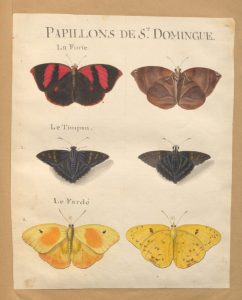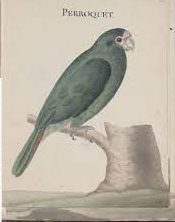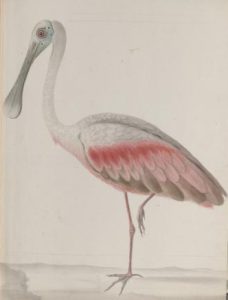Painting animals in 18th-century Saint-Domingue (now Haiti) 2024
‘Painting animals in 18th-century Saint-Domingue (now Haiti)’ by Professor Victoria Dickenson, McGill Library and Collections, online 17 April 2024 19:00-20:00 BST
 A joint event of the Animal History Group and SHNH – Society for the History of Natural History
A joint event of the Animal History Group and SHNH – Society for the History of Natural History
Register here: https://www.eventbrite.co.uk/e/ahg-seminar-april-17th-tickets-707754983207
Painting animals in 18th-century Saint-Domingue – the paintings of René Gabriel de Rabié (1717-1785)
by Professor Victoria Dickenson, McGill Library and Collections
Wednesday, 17 Apr 2024 19:00 – 20:00 BST, online
 Saint-Domingue (now Haiti) was the richest colony in the French Empire in the 18th century. Columbus visited the island of Hispaniola in 1492 and described great flocks of parrots darkening the skies. By the time the French engineer René Gabriel de Rabié (1717-85) arrived in 1742, the environment had been impacted by the intensive agriculture of sugarcane, coffee, indigo and cocoa plantations worked by enslaved peoples.
Saint-Domingue (now Haiti) was the richest colony in the French Empire in the 18th century. Columbus visited the island of Hispaniola in 1492 and described great flocks of parrots darkening the skies. By the time the French engineer René Gabriel de Rabié (1717-85) arrived in 1742, the environment had been impacted by the intensive agriculture of sugarcane, coffee, indigo and cocoa plantations worked by enslaved peoples.
In the 1760s, de Rabié began to paint the plants and animals he encountered around his home in Cap Français and on his travels around the coast. By the time he left the island to return to France in 1784, he had amassed hundreds of watercolour drawings, as well as notes on habitats, habits and local names. He was assisted in this enterprise of natural history documentation by his daughter Jacquette Anne Marie Rabié de la Boissière and by the many enslaved people who worked as gardeners, cooks, household servants, fishers, paddlers and divers.
 De Rabié was not the only European to document the novel (to him) flora and fauna he encountered in Saint Domingue. In addition to published records, there are numerous manuscript journals and drawings by engineers, members of the French military, doctors and plantation owners. These works reveal not only a European framework for the natural world, but also provide insight into the ways enslaved African and Indigenous peoples viewed this environment.
De Rabié was not the only European to document the novel (to him) flora and fauna he encountered in Saint Domingue. In addition to published records, there are numerous manuscript journals and drawings by engineers, members of the French military, doctors and plantation owners. These works reveal not only a European framework for the natural world, but also provide insight into the ways enslaved African and Indigenous peoples viewed this environment.
The four albums of de Rabié’s paintings are now preserved in the Blacker Wood Natural History Collection of McGill University Library in Montreal. Through close reading of original images, manuscript notes and published records, and through discussions with contemporary Haitian experts and residents, our research group is attempting to understand better how animals and people interacted on Saint Domingue in the 18th century, and how we can ensure a more inclusive documentation of historical records.
This research is part of the three-year research project Hidden Hands in Colonial Natural History Collections, funded through the Social Sciences and Humanities Research Council of Canada.
For more information on the Society please see www.shnh.org.uk.
 Archives of Natural History is the journal of the Society for the History of Natural History, publishing papers on the history and bibliography of all branches of natural history. For more information see https://www.euppublishing.com/loi/anh.
Archives of Natural History is the journal of the Society for the History of Natural History, publishing papers on the history and bibliography of all branches of natural history. For more information see https://www.euppublishing.com/loi/anh.
Registered Charity no. 2103555 in England and Wales